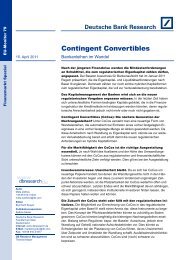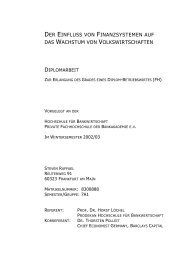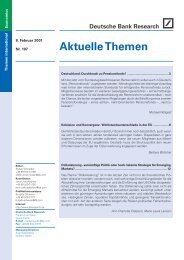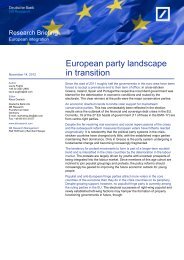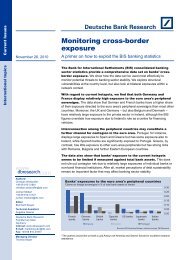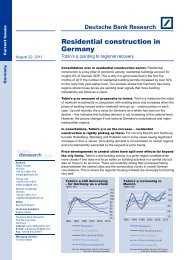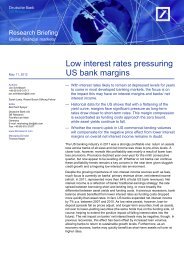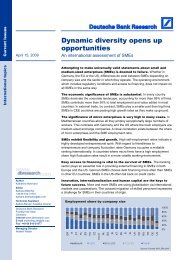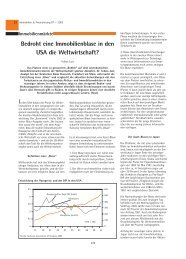Container shipping: Successful turnaround - Deutsche Bank Research
Container shipping: Successful turnaround - Deutsche Bank Research
Container shipping: Successful turnaround - Deutsche Bank Research
You also want an ePaper? Increase the reach of your titles
YUMPU automatically turns print PDFs into web optimized ePapers that Google loves.
<strong>Container</strong> <strong>shipping</strong> has<br />
recovered from recession<br />
Global container throughput, % yoy<br />
91 93 95 97 99 01 03 05 07 09<br />
20<br />
15<br />
10<br />
5<br />
0<br />
-5<br />
-10<br />
Source: Drewry 1<br />
World trade and container<br />
<strong>shipping</strong> closely correlated<br />
x-axis: world trade, % yoy<br />
y-axis: container throughput, % yoy<br />
20<br />
R² = 0.73<br />
15<br />
10<br />
-10<br />
-15<br />
-20 -10 0 10 20<br />
Sources: CPB Netherlands, Drewry, DB <strong>Research</strong> 2<br />
The biggest container ports<br />
in the world: Asia dominant<br />
<strong>Container</strong> throughput (million TEU)<br />
Singapore<br />
Shanghai<br />
Hong Kong<br />
Shenzhen<br />
Busan<br />
Guangzhou<br />
Dubai Ports<br />
Ningbo<br />
Qingdao<br />
Rotterdam<br />
Tianjin<br />
Kaohsiung<br />
Port Kelang<br />
Antwerp<br />
Hamburg<br />
Los Angeles<br />
Tanjung Pelepas<br />
Long Beach<br />
Xiamen<br />
Laem Chabang<br />
5<br />
0<br />
-5<br />
0 10 20 30<br />
2000 2009<br />
Source: Hafen Hamburg<br />
3<br />
Current Issues<br />
2009 sees global container throughput sink for the first<br />
time<br />
The global recession of 2008/09 hit the global container <strong>shipping</strong><br />
business hard. Global container throughput fell for the first time in<br />
the annals of the sector in 2009, contracting by over 9%, according<br />
to Drewry Shipping Consultants (Drewry). Prices (freight and charter<br />
rates) fell by between 50% and 80%. At its height some 12% of the<br />
fleet (based on lot capacity in TEU 1 ) was laid up, which means that<br />
at one stage about 600 ships had been taken out of service.<br />
According to information from Germany’s Verband <strong>Deutsche</strong>r<br />
Reeder (VDR), international <strong>shipping</strong> lines suffered losses of USD<br />
20 bn in 2009. The reasons for these losses are obvious: the global<br />
economic crisis was marked by a slump in trading activities and<br />
investment. This had a knock-on effect on container <strong>shipping</strong> since<br />
the fortunes of the sector are very closely correlated with global<br />
trade developments. 2<br />
From a regional standpoint it was the European and North American<br />
ports that were particularly hard hit by the recession. In 2009<br />
container throughput contracted by more than 16% at northern<br />
European ports and by over 13% in North America. The biggest<br />
decline of around 36% was posted by the eastern European ports<br />
(Baltic area, Black Sea, eastern Mediterranean) that are small by<br />
international standards. Several routes were completely suspended<br />
at these ports during the crisis. The decline in 2009 is, however, put<br />
into perspective by the fact that the eastern European ports had<br />
posted the highest growth rates for many years prior to the<br />
recession. Of the world’s 30 biggest ports Hamburg suffered the<br />
biggest decline at 28%. The deep slump in German external trade<br />
was one major reason. On top of this, several feeder services 3 from<br />
Hamburg to the Baltic area were temporarily suspended or transferred<br />
to competing ports (e.g. Rotterdam).<br />
Asian ports were less affected by the crisis as the economic<br />
environment there was much more favourable than in Europe and<br />
the US. In both the Far East and South Asia the decrease in<br />
container throughput in 2009 was about 8%; in the Middle East the<br />
decline was a mere 2%. Several Asian ports even managed to grow<br />
their container throughput in the crisis year of 2009 (e.g. Khor<br />
Fakkan in the United Arab Emirates: +30% to 2.8 m TEU).<br />
<strong>Container</strong> <strong>shipping</strong> enjoys multiple advantages<br />
Before the slump in container throughput in 2009 the sector posted<br />
very high growth rates. Between 1990 and 2008, for instance, global<br />
container throughput rose by an annual average rate of more than<br />
10%. The discrepancy between the 2009 figure and the prior longterm<br />
performance highlights the scale of the crisis.<br />
The reasons for the historically very high growth in container<br />
<strong>shipping</strong> include the increasing international division of labour and<br />
the growing liberalisation of world trade (e.g. China’s WTO<br />
accession in 2001). Furthermore, the share of goods that are ideal<br />
for <strong>shipping</strong> via container (semis and finished products) has risen<br />
steadily over the last few years, and advances in container<br />
technology allow more and more goods to be transported via<br />
1<br />
TEU stands for Twenty Foot Equivalent Unit and is the usual standard container<br />
size.<br />
2<br />
<strong>Container</strong> throughput invariably grows faster than world trade: between 1991 and<br />
2008 it expanded by 50% more than world trade.<br />
3<br />
Feeder services operate between the larger and smaller ports within a region.<br />
2 March 28, 2011



